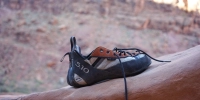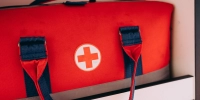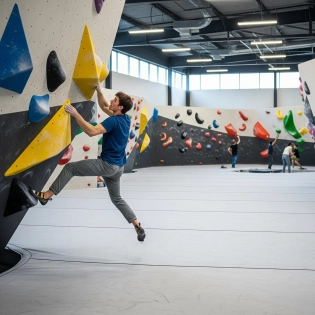







Climbers Point
Climbing shoes are not meant to hurt at first, but it's very likely that they will. New climbing shoes can have pressure points that will go away after the break in period.
A strong misconception in the climbing community is that new climbing shoes must be painful, if they are painfully tight, it means you have chosen the right size. This is not true, and it's a pretty dangerous way of approaching sizing climbing shoes.
Climbing shoes should be tight, but not so tight that they cause throbbing pain, or that they cut your blood circulation. They should just be very snug. Your feet should not be able to move freely within them, and you should have little to no dead space in them. This does not mean that you have to choose shoes that you can barely even get on your feet.
But, again, new climbing shoes CAN be painful in the beginning, but not to the point where the pain is throbbing or that you still feel the pain after you take your shoes off. The pain should be minimal.

Climbing shoes were not designed to be uncomfortable, but, given their general nature of being tight, snug, and not leaving any wiggle room for your toes or any space to move for your feet, they are uncomfortable.
Though climbing shoes are quite uncomfortable, you do get used to the general fit of climbing shoes after some time. Normally, people wear general sport shoes that are very padded, loose, and comfortable, and they get used to wearing these kinds of shoes their whole life. Squeezing your feet into shoes that are almost the complete opposite of what you have been used to your entire life, can and will be very uncomfortable.
As I mentioned, you do get used to how climbing shoes feel. If you find the right shoes for you that are the right size and that fit the shape of your feet, the shoes can in fact feel much more comfortable than you would expect.

Bouldering shoes are a reference to a type of climbing shoe that is meant for bouldering. While any type of climbing shoe can be used for any form of climbing, some shoes are made with a specific form of climbing in mind.
For example, bouldering shoes are normally more aggressive, meaning, they are bent downwards in the middle, and are usually slightly twisted towards the big toe. These attributes provide the climber with more support and the ability to exert extra force from the toes, while also giving them potential advantages on steep overhanging routes.
Flatter shoes are used more for longer routes, such as sport climbing, trad climbing, and multi-pitch routes. Climbing these types of routes while wearing flat shoes gives the climber better support in their feet, which means that their feet will not get as tired as they would in aggressive climbing shoes.
Of course, there is no rule when it comes to which shoes to wear and for which form of climbing. You can wear what ever you feel will help you get through the route the most.

If you cannot even put on your shoes, or they cause you throbbing pain, that is a clear sign that they may be too small for you. If while wearing and climbing in the shoes you cannot actually benefit from them and do things such as toe hooks because of the pain, then that is also a sign that the shoes may just be too small.
On the other hand, if you feel your feet slip and move around inside the shoes while climbing, then that is a sign that they may be too big. Your feet should not really be moving around inside your shoes while climbing, you should feel the support of the tight and snug fit of the shoes. If you do not feel this, they may be too big. If you have a lot of dead space in your shoes, meaning, air pockets between your feet and the shoes, this may also mean that the shoes are too big, or not the right fit for you.
There is a third option, which is that the shoes are just not the right fit for you. Climbing shoes come in all shapes and sizes. Some shoes have a wider toe box, and some have a more narrow heel area. It can be that you will find shoes that fit the size of your heel perfectly, but, the toe box is either too big or too small. This situation is much less about the actual size of the shoe, and more about the shoe not matching your feet.

A climbing shoe normally feels tight, snug, and applies a certain amount of pressure to your feet. This is especially true with new climbing shoes, as they have not yet been broken in. If the shoes are synthetic, they may not have a noticeable break in period, and however tight and snug they are when you buy them, may be how they feel even after a few months in them.
The same climbing shoes in the same size may also feel different for different people, as people have different shaped feet. The same shoes that may be applying a lot of pressure on your big toe, may be causing someone else some pain in another area of their foot. Everyone's feet are shaped differently and have different characteristics, so not all shoes will fit everyone the same, but, you do get used to most of the pressure after a short while.
Once you get used to wearing climbing shoes, a lot of the slight pains, discomforts, and other pressure points start to fade, and your feet get used to them.





